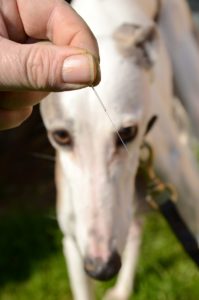
As human complementary medical therapies become more common, many owners want to know if alternative treatments can help their pets. Red Bank Veterinary Hospitals offer alternative therapies, including traditional Chinese medicine (TCM) and medical acupuncture. People often assume that TCM and acupuncture are the same types of treatment, but acupuncture is only one TCM facet, and the philosophies behind traditional Chinese acupuncture and medical acupuncture can differ. If this seems confusing, our guide will help you better understand how each therapy can help your pet.
What is traditional Chinese medicine?
TCM is a medical system that has been used in China for thousands of years. The system, which is based on the ancient Daoist philosophy that the body is an extension of the larger universe, considers not only your pet’s internal physiology, but also how the external universe relates to her health.
The body’s life energy, or Qi (pronounced “chi”), is believed to run through channels called meridians, controlling the body’s balance. The yin-yang theory, another important TCM belief, describes how opposing universal forces, such as hot and cold or light and dark, mutually interact to play a role in the body’s functions.
In TCM, an imbalance of Qi or yin and yang is believed to cause disease, and diagnosis focuses on identifying the source of disharmony. Since TCM addresses concepts such as a patient’s temperament, age, sex, activity, and environment, along with disease signs, it is considered a more holistic approach to patient care than Western medicine.
TCM is composed of four different therapy types:
Treatment can involve one TCM therapy, or a combination of therapies.
What is veterinary acupuncture?
Acupuncture involves the insertion of fine, sterile needles through the skin at specific points along the meridian channels through which Qi flows to stimulate healing and control pain. Individual points are selectively stimulated to produce specific actions to alleviate a pet’s medical condition.
Acupuncture can be used to treat a variety of conditions, including:
 Musculoskeletal problems, such as muscle strain, back pain, intervertebral disc disease, and degenerative joint disease
Musculoskeletal problems, such as muscle strain, back pain, intervertebral disc disease, and degenerative joint diseaseIf you are concerned about needles causing your pet pain, rest assured that most animals readily accept the small needles. Pets often become relaxed, and sometimes fall asleep during treatment. Acupuncture is an extremely safe form of therapy when performed by a certified veterinary acupuncturist, and can often be used in pets who cannot receive certain medications due to organ dysfunction or failure.
How does medical acupuncture differ from TCM?
Medical acupuncture relies on a knowledge of anatomy, physiology, pathology, and evidence-based medicine and research to effect a change in the body. A medical acupuncturist starts with a history and physical exam, including a special type of exam called a “myofascial exam.” During a myofascial exam, the practitioner examines the muscles, joints, tendons, and connective tissues that unite all of the body structures, and can allow the identification of locations and sources of pain, discomfort, and dysfunction.
Once these sources are identified, a treatment plan is created to correct the dysfunction through neuromodulation. Neuromodulation involves activating nerve pathways through stimulation of acupuncture points, both at the primary site of the problem, and across the pet’s body. When a needle is inserted into an acupuncture point, the nerve fibers near the point are activated, and send a signal from the “periphery” (the acupuncture point) to the central nervous system (the brain and spinal cord) and autonomic nervous system centers (that govern processes like glandular activity, immune function, digestion, mood, and more). Acupuncture needles also interact with muscles and the connective tissues that surround them, releasing tension, trigger points, and pain.
Medical acupuncture is similar to TCM acupuncture in that many of the points used are the same; however, instead of basing the dysfunction on the construct of Qi imbalance, the source of the problems are rooted in physiologic disturbances. Medical acupuncture’s treatment and effectiveness also relies on evidence-based medicine rather than anecdotal support.
Is medical acupuncture or TCM a better treatment option for my pet?
One advantage of TCM’s complementary therapies is that they can be used in conjunction with Western medical treatments, including medical acupuncture. One approach is not necessarily better than the other, and TCM and Western treatment modalities can often be used together to afford patients the advantages of both. Both TCM and medical acupuncture can be successful in treating a variety of diseases. The mindset of the practitioner and the approach to the patient do differ, and both can be part of a comprehensive treatment plan.
If you think your pet could benefit from medical acupuncture or TCM therapies, contact us. We are happy to work with your family veterinarian to offer your pet a wider range of treatment options for her medical condition.